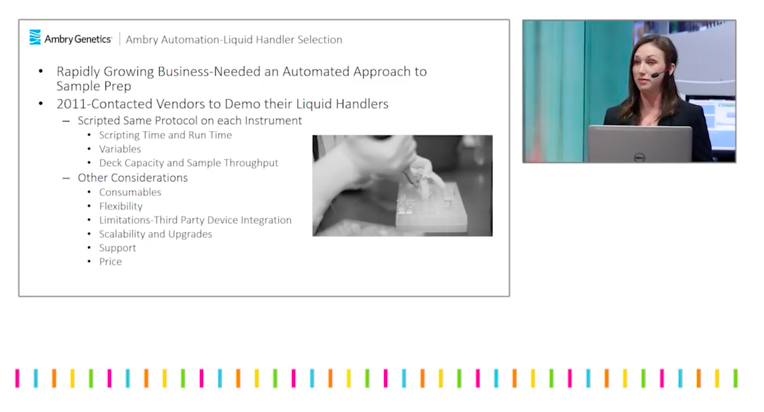SLAS2017 Presentation by Joy Rae-Radecki Crandall, Ambry Genetics
Ambry Genetics operates a CLIA-licensed genetics testing laboratory that processes clinical samples primarily using next-generation sequencing (NGS), followed by Sanger sequencing to verify clinically relevant results and reduce false positives.
The company initiated a major project to automate their protocols to reduce test turnaround time to as low a level as possible. After comparing multiple liquid handlers and considering a broad range of factors, including turnaround, consumables, flexibility, limitations associated with third-party device integration, scalability and upgrades, support, and price, Ambry selected the Fluent®.
Key features that led Ambry to choose Fluent were the ease of programming of the software, its capability for sample and reagent tracking, and the simplicity of script import and export. On the hardware side, desirable features included the system's deck capacity, in-field integrations and upgrades, and simple third-part device integrations. Implementation of its first Fluent allowed Ambry to replace many of the time-consuming manual processes performed by technicians -- such as normalization, pooling, and hit-picking steps -- with a single Clinical Laboratory Specialist (CLS) for set-up and walkaway automation on the 8-channel liquid handling device. It also allowed Ambry to transition from microcentrifuge tubes to 96-matrix tube racks for sample storage and from microcentrifuge tubes to 96-well plates for processing, each of which increased deck capacity 3-fold. This also led to a minimum 12x faster processing, a reduced risk of error, less labeling, and easier sample tracking.
The integration of a 96-channel multiple channel arm for all sample and reagent transfers greatly increased throughput and made it possible to increase the number of samples prepped per CLS by 25x-100x per week. The faster processing reduced reagent exposure, facilitating the use of temperature- or light-sensitive reagents. Ms. Crandall explained that Ambry could overcome many of the obstacles and limitations related to user training, scheduling, flexibility, and demand for the system, and redundancy needs by adding additional Fluent instruments to the laboratory.
Ultimately, in 2016, Ambry built a SuperLab, with numerous Fluent systems in operation. Instead of building customized decks for particular assays, Ambry opted for a more generic deck set-up that could easily accommodate different types of assays and took advantage of the system's customizable, scalable deck design. Ms. Crandall described the addition of Carousel sample storage units with barcode readers and an automated sample receiving and processing system, all integrated with the Fluent and the laboratory's LIMS. The advances in automated liquid handling and sample and plate tracking led to improvements in throughput, traceability, quality control metrics, laboratory visibility, reagent and consumables costs, waste management, user training, and system maintenance across the entire workflow.
About the author

Kevin Moore
Kevin Moore is Head of Markets and Applications based out of Tecan’s head office in Männedorf, Switzerland. He heads the team tasked with bringing both products and application for the liquid handling to the market. Prior to joining Tecan in 2007, he was head of Compound Management and Technology project manager for the Neuroscience Research Centre of Merck & Co in the UK, where he worked for Merck for 20 years.












